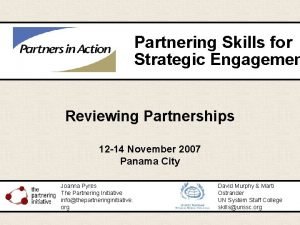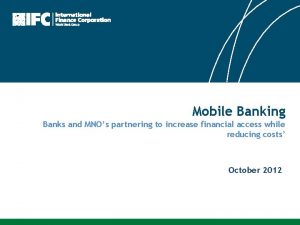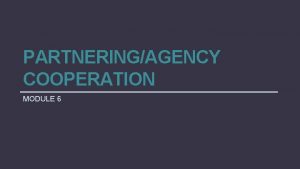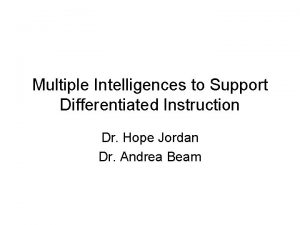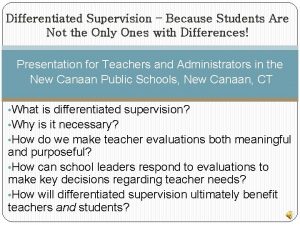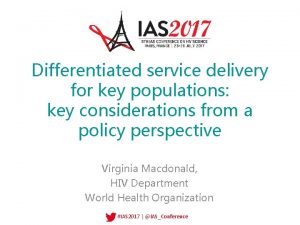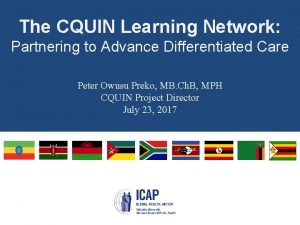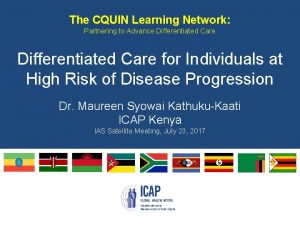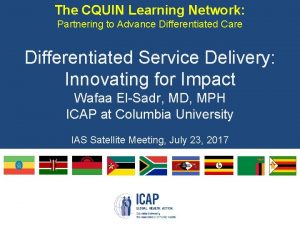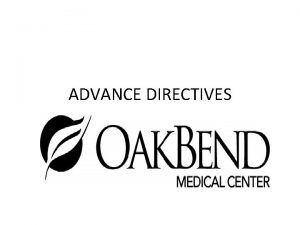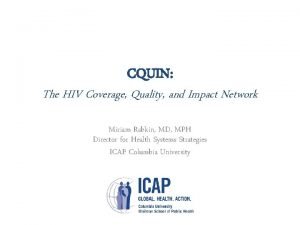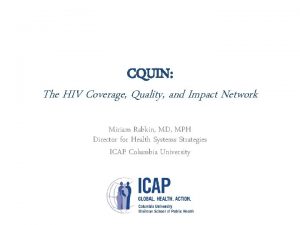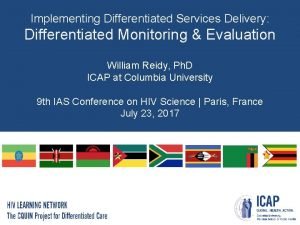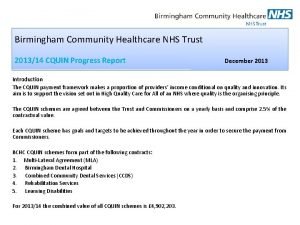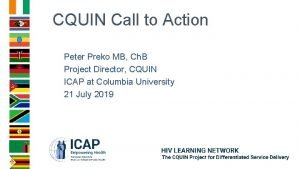The CQUIN Learning Network Partnering to Advance Differentiated

![Global Scale-up of HIV Treatment [VALUE] 20 18 Millions 16 14 12 10 8 Global Scale-up of HIV Treatment [VALUE] 20 18 Millions 16 14 12 10 8](https://slidetodoc.com/presentation_image_h/999c7bda22f0f092fee3fb96f303693f/image-2.jpg)

![Reaching the 90/90/90 Targets 70% 77% 85% [51 -84%] [57 - >89%] [60 - Reaching the 90/90/90 Targets 70% 77% 85% [51 -84%] [57 - >89%] [60 -](https://slidetodoc.com/presentation_image_h/999c7bda22f0f092fee3fb96f303693f/image-4.jpg)














- Slides: 18

The CQUIN Learning Network: Partnering to Advance Differentiated Care Differentiated Service Delivery: Innovating for Impact Wafaa El-Sadr, MD, MPH ICAP at Columbia University IAS Satellite Meeting, July 23, 2017
![Global Scaleup of HIV Treatment VALUE 20 18 Millions 16 14 12 10 8 Global Scale-up of HIV Treatment [VALUE] 20 18 Millions 16 14 12 10 8](https://slidetodoc.com/presentation_image_h/999c7bda22f0f092fee3fb96f303693f/image-2.jpg)
Global Scale-up of HIV Treatment [VALUE] 20 18 Millions 16 14 12 10 8 6 4 2 0 2003 2004 2005 2006 2007 2008 2009 2010 Years 2011 2012 2013 2014 2015 2016 Eastern and southern Africa Asia and the Pacific Western and central Africa Western and central Europe and North America Latin America Eastern Europe and central Asia Caribbean Middle East and North Africa

HIV Treatment-- Global Targets By 2020 90% of all PLWH will know their HIV status 90% of all PLWH will receive sustained antiretroviral therapy CQUIN: The HIV Learning Network 90% of all PLWH receiving antiretroviral therapy will have durable suppression UNAIDS 2014
![Reaching the 909090 Targets 70 77 85 51 84 57 89 60 Reaching the 90/90/90 Targets 70% 77% 85% [51 -84%] [57 - >89%] [60 -](https://slidetodoc.com/presentation_image_h/999c7bda22f0f092fee3fb96f303693f/image-4.jpg)
Reaching the 90/90/90 Targets 70% 77% 85% [51 -84%] [57 - >89%] [60 - >89%] of people living with HIV know their status of people living with HIV who know their status are on treatment of people on treatment are virally suppressed UNAIDS. Ending AIDS. Progress towards the 90 -90 -90 targets, 2017

Stark Gaps in Continuum among Key Populations Gay men and other men who have sex with men (Moscow) 13% 36% 64% People who inject drugs (India) 41% 52% 83% Gay men and other men who have sex with men (India) 30% 68% 78% of PLHIV know their status of PLHIV who know their status are on treatment of PLHIV on treatment are virally suppressed UNAIDS. Ending AIDS. Progress towards the 90 -90 -90 targets, 2017

Barriers to Epidemic Control • Coverage – Access (geographic, language, cultural competency) – Demand (uptake by communities and clients) • Quality – Technical quality (safety, evidence-based) – Interpersonal quality (respectful care) • Efficiency – For health system – For clients CQUIN: The HIV Learning Network 6

Putting People at the Center WHICH? Which clinical, laboratory and supportive services are needed? WHERE? Where are services being provided? SERVICE FREQUENCY SERVICE INTENSITY WHEN? How often are services provided? People Living With HIV SERVICE LOCATION SERVICE PROVIDERS WHO? Who is providing services?

Program Design “Control Knobs” Service Frequency Monthly Bimonthly Every 6 months Every 12 months Service Intensity ART initiation and refills OI prevention and treatment Clinical monitoring Laboratory monitoring Psychosocial support 90: 90 Quality of Life Efficiency Service Location Hospital (inpatient or outpatient) HIV clinic Primary care clinic Community Home Service Provider Physician Nurse Pharmacist Peer Clinical Officer CHW Laboratorian Family Equity Epidemic Control

Differentiated Service Delivery to the Rescue? In response to concerns about coverage, quality and efficiency, many global and national guidelines now recommend the use of differentiated service delivery: “A client-centered approach that simplifies and adapts HIV services across the cascade to reflect the preferences and expectations of various groups of people living with HIV while reducing unnecessary burdens on the health system. ” – IAS CQUIN: The HIV Learning Network 9

Differentiating Services for Multiple Groups IAS 2016

Defining Stable Patients • Receiving ART for at least 1 year AND • No adverse drug reaction AND • No current illnesses or pregnancy AND • Good understanding of lifelong adherence AND • Evidence of treatment success: – Two consecutive undetectable viral load – Rising CD 4 count or CD 4>200 cells/mm 3 and adherence measure www. differentiatedcare. org Waldrop et al. Trop Med & Intern Health, 2016

Beyond “Stable Patients” • Pregnant/post-partum women • Patients at high risk (advanced disease, unsuppressed viral load) • Men • Children and adolescents • Patients with HIV and comorbid conditions (TB, NCD) • Migrants/mobile populations • Key populations • Older PLWHIV

Coverage, Quality and Impact Network (CQUIN) Ethiopia Kenya Malawi Mozambique South Africa Swaziland Uganda Zambia Zimbabwe CQUIN: The HIV Learning Network 13

The CQUIN Learning Network Focus is on joint learning towards scale-up of differentiated service delivery models (DSDM) in order to improve coverage, quality and efficiency • Knowledge exchange, sharing and learning • Knowledge co-creation, especially where models, tools, resources are new and/or scarce CQUIN: The HIV Learning Network 14

https: //cquin. icap. columbia. edu CQUIN: The HIV Learning Network 15

www. differentiatedcare. org CQUIN: The HIV Learning Network 16

Today’s Agenda • Framing remarks: Drs. Tsitsi Apollo & Bactrin Killingo • Introduction to CQUIN: Dr. Peter Preko • DSD for individuals at high risk of disease progression: Dr. Maureen Syowai • Differentiated Monitoring & Evaluation: Dr. William Reidy • Mozambique CAG update: Dr. Aleny Couto • DSD for individuals w/HIV and NCDs: Dr. Nomthandazi Lukhele • The view from civil society: Dr. George Ayala CQUIN: The HIV Learning Network 17

Thank You
 Differentiated learning theories
Differentiated learning theories Partnering to build customer relationships
Partnering to build customer relationships The partnering initiative
The partnering initiative Mnos partnering
Mnos partnering Finance business partnering definition
Finance business partnering definition What is partnering
What is partnering Partnering session
Partnering session Multiple intelligences and differentiated instruction
Multiple intelligences and differentiated instruction Entry points differentiated instruction
Entry points differentiated instruction Entry points differentiated instruction
Entry points differentiated instruction Diffserv vs intserv
Diffserv vs intserv Integrated vs differentiated curriculum
Integrated vs differentiated curriculum Individualized instruction vs differentiated instruction
Individualized instruction vs differentiated instruction Think dots differentiated instruction
Think dots differentiated instruction Think dots differentiated instruction
Think dots differentiated instruction Concentrated marketing
Concentrated marketing Differentiated questioning
Differentiated questioning Differentiated supervision
Differentiated supervision Differentiated service delivery
Differentiated service delivery


